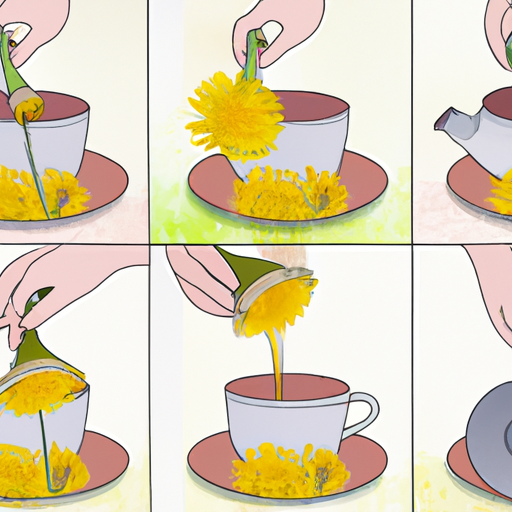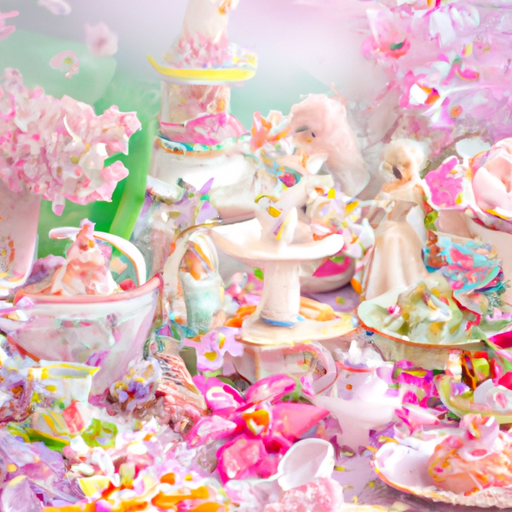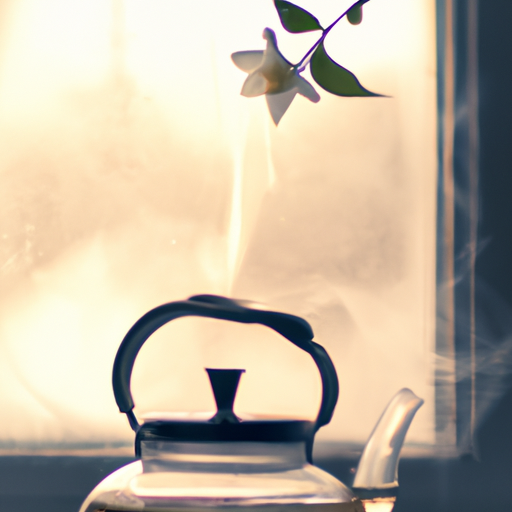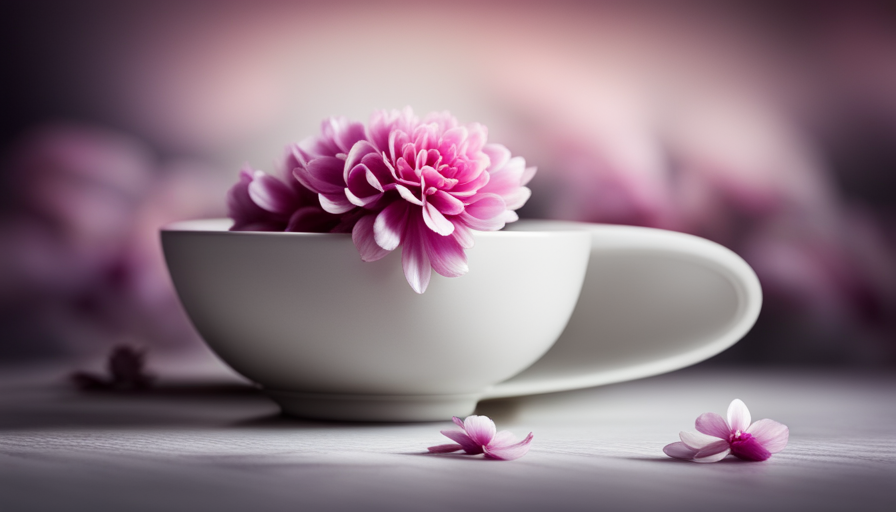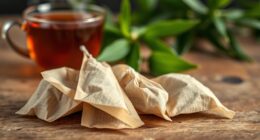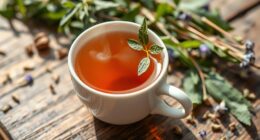When it comes to beverages, there is nothing quite as unique and delightful as dandelion flower tea. Made from the vibrant yellow petals of the dandelion flower, this herbal infusion offers a plethora of health benefits and a distinct, earthy flavor that is sure to tantalize your taste buds.
In this article, I will guide you through the process of making dandelion flower tea, from gathering fresh flowers to brewing the perfect cup. With detailed instructions and scientific insights, you will become an expert in crafting this exquisite beverage right in the comfort of your own home.
But it doesn’t stop there – I will also share tips on adding flavors and enhancements to take your tea to the next level. So, get ready to embark on a journey of sensory delight and discover the wonders of dandelion flower tea.
Let’s dive in!
Key Takeaways
- Dandelion flower tea is made from the petals of the dandelion flower and has a unique and delightful taste with an earthy flavor.
- It supports liver health, acts as a natural diuretic, stimulates the production of digestive enzymes, and has anti-inflammatory properties.
- To make dandelion flower tea, gather fresh flowers from pesticide-free areas, clean them, and steep them in boiling water for 10 minutes.
- Enhance the dandelion flower tea by adding flavors and enhancements like lemon and honey, mint and ginger, or cinnamon and vanilla.
The Benefits of Dandelion Flower Tea
Did you know that dandelion flower tea offers a wide range of health benefits? This herbal infusion, derived from the yellow petals of the dandelion plant, has been used for centuries to promote well-being.
One of the key benefits of dandelion flower tea is its ability to support liver health. It contains compounds like flavonoids and antioxidants that help detoxify the liver and improve its function. Additionally, this tea acts as a natural diuretic, aiding in the elimination of toxins from the body through increased urine production.
Another advantage of dandelion flower tea is its potential to support digestion. It stimulates the production of digestive enzymes, which can enhance nutrient absorption and alleviate symptoms such as bloating and indigestion. Moreover, dandelion flower tea has anti-inflammatory properties that may help reduce inflammation in the body, resulting in improved overall health.
To prepare dandelion flower tea, gather fresh dandelion flowers from pesticide-free areas. Rinse them thoroughly to remove any dirt or debris. Next, boil water and pour it over the flowers, allowing them to steep for about 10 minutes. Strain the liquid and enjoy the flavorful and beneficial dandelion flower tea.
Now, let’s move on to the next section about gathering fresh dandelion flowers and preparing them for tea.
Gathering Fresh Dandelion Flowers
Once you’ve found a suitable location, start by picking vibrant yellow flowers with long green stems. It’s important to choose flowers that are fully open and free from any signs of damage or decay. When foraging for dandelion flowers, it’s best to gather them in the morning when they’re at their freshest.
To ensure sustainability and allow the plants to continue growing, only pick a few flowers from each plant, leaving the majority of them intact. This will also ensure a continuous supply of flowers for future foraging.
When gathering dandelion flowers, it’s essential to use proper foraging techniques. Gently hold the stem of the flower near its base and carefully pluck it from the plant, taking care not to damage the surrounding foliage. It’s advisable to bring a small basket or container to collect the flowers, ensuring they remain intact during transportation.
Once you’ve gathered a sufficient amount of dandelion flowers, you can proceed to cleaning and preparing them for use in various dandelion flower recipes.
Cleaning and Preparing the Flowers
To get the dandelion flowers ready for use, it’s time to give them a thorough cleaning and get them prepped. Cleaning techniques are important to remove any dirt, insects, or other impurities from the flowers. Start by gently rinsing the flowers under cool water to remove any loose debris. Then, fill a bowl with water and add a teaspoon of salt. Soak the flowers in this saline solution for about 10 minutes to help eliminate any remaining pests. After the soaking process, rinse the flowers again to remove the salt residue.
Once the flowers are clean, it’s crucial to dry them properly to avoid spoilage. Spread the flowers out on a clean kitchen towel or paper towels, making sure they are in a single layer. Place them in a well-ventilated area away from direct sunlight. Allow them to air dry for a few hours or overnight until they are completely dry and brittle to the touch.
Now that the dandelion flowers are cleaned and dried, they are ready to be used for making delicious dandelion flower tea. In the next section, we will explore the various brewing methods for this delightful tea, which will further enhance the flavors and benefits of the dandelion flowers.
Brewing Methods for Dandelion Flower Tea
When it comes to brewing dandelion flower tea, there are three main methods that can be used. The Simple Infusion Method involves steeping the flowers in hot water for a short period of time, usually around 5-10 minutes.
The Cold Brew Method, on the other hand, requires the flowers to be soaked in cold water for an extended period of time, usually overnight, to extract the flavors more slowly.
Lastly, the Steaming Method involves steaming the flowers to release their aromatic compounds, resulting in a more delicate and nuanced flavor profile.
Simple Infusion Method
Imagine yourself in a cozy kitchen, gently placing dried dandelion flowers into a teapot, ready to brew a warm and soothing cup of dandelion flower tea. This simple infusion method allows you to fully enjoy the infusion variations and health properties of dandelion flower tea. Here are four simple steps to make this delightful beverage:
- Boil water in a kettle.
- Measure one teaspoon of dried dandelion flowers for every cup of water.
- Place the flowers in a teapot and pour the hot water over them.
- Let the tea steep for about 5 minutes.
This method extracts the beneficial compounds from the flowers, such as antioxidants and anti-inflammatory agents. The resulting tea has a mild, earthy flavor with a hint of sweetness.
Now, let’s transition to the subsequent section about the ‘cold brew method’, which offers a refreshing twist to your dandelion flower tea experience.
Cold Brew Method
Get ready for a refreshing twist on your dandelion flower tea experience with the cold brew method. This alternative brewing method offers a unique set of benefits that can enhance your tea-drinking experience.
Cold brewing involves steeping the dandelion flowers in cold water for an extended period, usually overnight, to extract the flavors and nutrients slowly. The slow infusion process allows for a smoother and less bitter taste compared to traditional hot brewing methods.
Additionally, the cold brew method retains more of the flower’s delicate floral aroma and preserves its natural color. The resulting tea is not only refreshing but also packed with antioxidants and other beneficial compounds.
Now, let’s explore the next brewing method, the steaming method, to further expand your dandelion flower tea repertoire.
Steaming Method
Discover a new way to infuse the flavors of dandelion flowers into your beverage with the steaming method, providing a unique and aromatic twist to your tea experience.
Steaming techniques for other types of flowers can also be applied to dandelion flowers, allowing you to extract their essence while preserving their delicate flavors. The steaming method involves placing the dandelion flowers in a heat-resistant container, such as a glass bowl, and suspending it over a pot of simmering water. As the steam rises, it gently heats the flowers, causing them to release their flavor and aroma into the surrounding air.
This technique is often used in skincare products as well, as the steam helps to extract the beneficial compounds from the flowers, which can then be incorporated into lotions, creams, and other beauty products.
Transitioning into the next section about ‘adding flavors and enhancements,’ you can further enhance the dandelion tea by infusing it with additional herbs and spices.
Adding Flavors and Enhancements
When it comes to adding flavors and enhancements to dandelion flower tea, there are several options to choose from.
One popular choice is to add a squeeze of lemon and a drizzle of honey, which adds a refreshing and sweet twist to the tea.
Another option is to add a few sprigs of mint and a slice of ginger, which gives the tea a cool and invigorating flavor.
Lastly, you can try adding a sprinkle of cinnamon and a splash of vanilla, which creates a warm and comforting taste to the tea.
Experimenting with these flavors can elevate your dandelion flower tea experience and add a unique twist to this already delightful beverage.
Lemon and Honey
To add an extra burst of flavor and sweetness to your dandelion flower tea, squeeze a generous amount of zesty lemon juice and drizzle in a dollop of golden honey – it’s like a refreshing explosion in your mouth!
Lemon and honey are not only delicious but also bring additional health benefits to your tea. Lemon is rich in vitamin C, boosting your immune system and aiding digestion. Honey, on the other hand, acts as a natural sweetener and is known for its antimicrobial properties. It can soothe a sore throat and provide relief from coughing.
For those looking for alternative sweeteners, lemon and honey are perfect choices.
Now, let’s move on to the next section where we explore the flavors of mint and ginger in your dandelion flower tea.
Mint and Ginger
After exploring the refreshing combination of lemon and honey, let’s dive into another exciting flavor pairing for our dandelion flower tea: mint and ginger. Mint, known for its invigorating aroma and cooling sensation, brings a unique set of benefits to our tea. It aids in digestion, relieves headaches, and helps to alleviate stress and fatigue. Ginger, on the other hand, adds a warm and spicy kick to the tea. Its flavors are known to enhance the overall taste profile and provide a soothing effect on the stomach. Combining mint’s benefits with ginger’s flavors creates a delightful and invigorating experience. To give you an idea of the different flavors and benefits these ingredients bring, here is a table showcasing the key characteristics of mint and ginger:
| Mint | Ginger |
|---|---|
| Refreshing aroma | Warm and spicy |
| Aids digestion | Soothes the stomach |
| Relieves headaches | Enhances taste profile |
| Alleviates stress and fatigue | – |
Now, we move on to the next exciting subtopic: cinnamon and vanilla.
Cinnamon and Vanilla
Spice up your taste buds with the enticing flavors of cinnamon and vanilla. Not only do these two ingredients add a delightful twist to your dandelion flower tea, but they also offer a range of health benefits.
Cinnamon, known for its warm and sweet taste, has been used for centuries due to its medicinal properties. It helps regulate blood sugar levels, reduce inflammation, and boost brain function.
Vanilla, on the other hand, adds a smooth and creamy flavor to your tea. Additionally, it has antioxidant properties and can help reduce anxiety and improve mood.
By adding cinnamon and vanilla to your dandelion flower tea, you not only enhance the taste but also gain the added benefits of these incredible ingredients.
Now, let’s delve into the health benefits of dandelion flower tea.
Health Benefits of Dandelion Flower Tea
Don’t underestimate the health benefits of dandelion flower tea – did you know that it contains high levels of antioxidants, which can help reduce inflammation in the body? Dandelion flower tea has been used for centuries as a natural detoxifier, helping to cleanse the liver and kidneys of toxins. This makes it an excellent choice for those looking to support their body’s natural detoxification processes.
Additionally, dandelion flower tea is known for its positive effects on digestive health. It can help stimulate the production of digestive enzymes, aiding in the breakdown and absorption of nutrients. The tea also has mild diuretic properties, which can promote healthy kidney function and reduce water retention.
Incorporating dandelion flower tea into your daily routine can have numerous benefits for your overall well-being. Here are three sub-lists to further illustrate its advantages:
-
Detoxification:
- Supports liver and kidney function
- Helps eliminate toxins from the body
- Promotes a healthy skin complexion
-
Digestive Health:
- Stimulates digestive enzyme production
- Aids in nutrient absorption
- Soothes digestive discomfort
-
Diuretic Effects:
- Promotes healthy kidney function
- Reduces water retention
- Supports urinary tract health
With its detoxifying and digestive health benefits, dandelion flower tea is a natural choice for those seeking to improve their overall wellness. Now, let’s move on to frequently asked questions about dandelion flower tea.
Frequently Asked Questions about Dandelion Flower Tea
One common query about dandelion flower tea is its recommended daily intake for maximum health benefits. Dandelion flower tea is known for its numerous health benefits, such as promoting digestion, detoxifying the liver, and boosting the immune system. However, it’s important to consume it in moderation to avoid any potential side effects. The recommended daily intake of dandelion flower tea is typically 1-2 cups per day. This amount provides enough of the beneficial compounds found in the tea without overwhelming the body.
When consuming dandelion flower tea, it’s important to be aware of any potential side effects. While generally safe for most individuals, some people may experience allergic reactions or stomach discomfort. It’s always recommended to start with a small amount and observe how your body reacts before increasing the intake.
Incorporating dandelion flower tea into your daily routine can provide a range of health benefits, but it’s essential to consume it in moderation and be mindful of any potential side effects. With its numerous health benefits and few side effects, dandelion flower tea can be a great addition to a healthy lifestyle.
Moving on to the next section about storing and shelf life of dandelion flower tea, it’s important to understand how to preserve the tea to maintain its freshness and potency.
Storing and Shelf Life of Dandelion Flower Tea
After learning about the frequently asked questions regarding dandelion flower tea, let’s now delve into the topic of storing and shelf life of this delightful beverage. Proper storage methods are essential to preserve the freshness and quality of dandelion flower tea. Here are some key points to keep in mind:
- Store your dandelion flower tea in an airtight container to prevent moisture and oxygen from degrading its flavor and potency.
- Keep the container in a cool, dark place, away from direct sunlight, as light can cause the tea to deteriorate faster.
- Avoid storing dandelion flower tea near strong-smelling substances, as it can absorb odors easily.
- Check the expiration date on the packaging, if available, to ensure freshness.
- To extend the shelf life, consider freezing the tea in ice cube trays and then transferring the frozen cubes into a resealable bag.
By following these storing methods, you can enjoy the vibrant flavors and health benefits of dandelion flower tea for a longer period.
Now that we have covered the topic of storing and shelf life, let’s explore the exciting possibilities and uses of dandelion flowers in the next section.
Exploring Other Uses for Dandelion Flowers
Discover the myriad of imaginative ways you can incorporate the sunny essence of dandelion blossoms into your culinary creations and DIY projects. Dandelion flowers aren’t just visually appealing but also offer a range of medicinal properties.
These vibrant yellow flowers have been used for centuries in traditional medicine to support liver health, aid digestion, and reduce inflammation. By harnessing their potential, you can explore various dandelion flower recipes to enjoy their benefits.
One popular use of dandelion flowers is in salads and soups. The petals add a subtle bitterness and vibrant color to any dish. You can also infuse them into oil or vinegar to create flavorful dressings or marinades.
Additionally, dandelion flower tea can be brewed by steeping the petals in hot water. This aromatic infusion not only has a delightful taste but also offers potential health benefits.
Enjoying the delightful taste of dandelion flower tea is just one way to experience the wonders of this versatile flower. By exploring its medicinal properties and incorporating it into your culinary creations, you can unlock a world of flavors and potential health benefits.
So, let’s delve further into the process of making dandelion flower tea.
Conclusion: Enjoying the Delightful Taste of Dandelion Flower Tea
Embrace the joy of indulging in the delightful taste of dandelion flower tea and savor the warm, comforting essence that’ll transport your senses to a place of tranquility and bliss.
As we’ve explored the various uses of dandelion flowers, it’s time to delve into the world of dandelion flower tea and all its wonderful flavors and health benefits.
When it comes to exploring different tea flavors, dandelion flower tea is a unique and exciting option. The delicate, floral notes of the dandelion flowers combine with a subtle bitterness to create a well-balanced and refreshing cup of tea. Whether you prefer it plain or with a touch of honey, this tea is sure to delight your taste buds.
But the taste isn’t the only reason to enjoy dandelion flower tea. Herbal teas, like dandelion flower tea, have long been praised for their health benefits. Rich in antioxidants and minerals, this tea can help support digestion, boost liver function, and even promote healthy skin. It’s a natural diuretic, which can aid in detoxification and fluid balance in the body.
So, as you sip on a cup of dandelion flower tea, you can not only enjoy its delightful taste but also reap its numerous health benefits. Give yourself a moment of tranquility and bliss with this exquisite tea.
Frequently Asked Questions
Can dandelion flower tea help with weight loss?
Dandelion flower tea offers numerous benefits, including potential weight loss support. Studies suggest that this herbal tea may help increase metabolism, reduce appetite, and promote detoxification. Incorporating dandelion flower tea into your weight loss regimen can be a wise choice. To reap its benefits, try incorporating it into your daily routine by following simple recipes. Remember to consult with a healthcare professional before making any significant dietary changes.
Are there any side effects of drinking dandelion flower tea?
There are few reported side effects of drinking dandelion flower tea. However, it’s always important to consult with a healthcare professional before incorporating any herbal tea into your routine.
Dandelion flower tea has numerous benefits, including supporting liver health. It contains antioxidants that may help protect the liver from damage and improve its function.
Additionally, dandelion flower tea can aid in digestion and promote overall wellness.
Can dandelion flower tea help with digestive issues?
Dandelion flower tea has been known to aid with digestive issues. It acts as a natural diuretic, promoting fluid elimination and reducing water retention. The tea’s high content of antioxidants helps to reduce inflammation and soothe the digestive system. Additionally, dandelion flower tea stimulates the production of bile, which aids in digestion and the breakdown of fats. Incorporating this tea into your diet can provide these digestive benefits along with the other numerous health benefits dandelion flower tea offers.
How often should I drink dandelion flower tea?
In terms of weight management and health benefits, I recommend incorporating dandelion flower tea into your daily routine. As an avid tea drinker myself, I find that enjoying a cup of this herbal infusion is a delightful way to boost my metabolism and support my digestive system.
To fully reap the benefits, I suggest drinking dandelion flower tea once or twice a day. Its natural diuretic properties can aid in detoxification and promote overall well-being.
Can I use dried dandelion flowers to make the tea instead of fresh ones?
Yes, you can use dried dandelion flowers to make tea instead of fresh ones. There are several benefits to using dried flowers for tea. Drying the flowers helps to preserve their nutrients and medicinal properties, making them more potent. Additionally, dried flowers have a longer shelf life and are easier to store. To make the tea, simply steep the dried flowers in hot water for about 10-15 minutes.
Conclusion
After exploring the various benefits and methods of making dandelion flower tea, it’s clear that this delightful beverage isn’t only delicious but also packed with health benefits. While some may be hesitant to try dandelion flower tea due to its association with weeds, it’s important to remember that dandelions are actually rich in vitamins, minerals, and antioxidants. By incorporating dandelion flower tea into your daily routine, you can support your overall well-being and enjoy a unique and refreshing drink.
Don’t let the misconception of dandelions hold you back from experiencing the wonders of dandelion flower tea.

